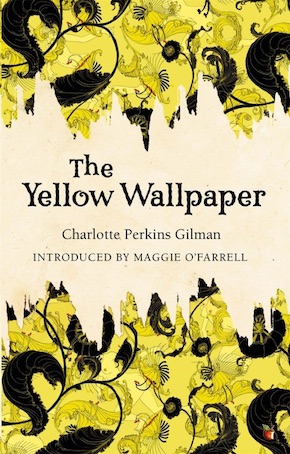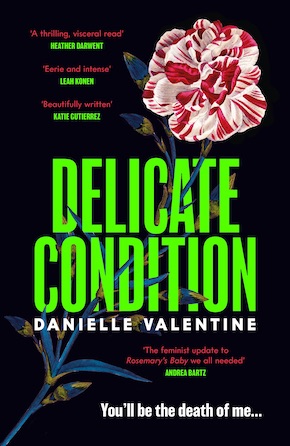Charlotte Perkins Gilman: ‘The Yellow Wallpaper’
by Danielle Valentine
I recently found myself on the horror side of BookTok, scrolling through video after video recommending “books that will rattle me to my core” and “scary fall reads” when something intrigued me enough to stop scrolling.
A young man stared into the camera, carefully holding a book so that the viewer couldn’t immediately see the cover. “In my last video, I asked you about the scariest book or short story you’d ever read,” he said. “You responded overwhelmingly with this one.”
The scariest book you’d ever read. That kind of hook was like catnip to me. I studied the book he held to see if I could figure it out. The spine looked thin and sort of vintage. Something old, then? I felt a lift of hope, thinking it was something by Shirley Jackson. I love when people recommend female writers. As I waited for the BookToker to turn the book cover side out, I made a little promise to myself to read or reread whatever the book was.
But when he flipped the cover toward the camera I frowned, certain this couldn’t be right. The “book” was ‘The Yellow Wallpaper’, by Charlotte Perkins Gilman.
Let me back up a moment to say that I love ‘The Yellow Wallpaper’. Like many other English majors, I first read it in college, probably in a class on American Literature or Short Stories. When you’re an English major, you tend to read a lot of very old stuff by dead white men. Don’t get me wrong, some of it is very, very good (T.S. Eliot’s ‘Prufrock’ stands out as a gem) but a lot of it can feel dated and obtuse and inaccessible, even for someone who loves to read.
Scariest book of all time? In a world that includes The Haunting of Hill House and House of Leaves? I had my doubts. But, true to my earlier promise, I decided it was time to read ‘The Yellow Wallpaper’ again.”
I remember ‘The Yellow Wallpaper’ being a breath of fresh air. Which isn’t to say it was a lighthearted read. Quite the opposite. From what I remember many years (er, decades) after first reading the story, ‘The Yellow Wallpaper’ is about a woman who goes to the countryside with her husband shortly after giving birth to her first child. She’s kept in a room with – you guessed it – hideous yellow wallpaper, where she slowly goes mad. By the last page, she’s crawling – creeping – around the room, completely feral. I even recently did some light research on Charlotte Perkins Gilman for my new novel, Delicate Condition, which is a horror story about pregnancy and the way the medical establishment and society treat pregnant women. Horrifyingly, Gilman was inspired to write ‘The Yellow Wallpaper’ because of her own experiences with postpartum depression, and with the then very well-known “rest cure” which had been popularised in the 19th century, and was prescribed for her, by Dr Silas Weir Mitchell.

This is all to say that I’m a fan. But… scariest book of all time? In a world that includes The Haunting of Hill House and House of Leaves? I had my doubts. But, true to my earlier promise, I decided it was time to read ‘The Yellow Wallpaper’ again.
I’m lucky that I don’t have to dig through my old school books to find a copy. ‘The Yellow Wallpaper’ is available online, for free. Adorably, the version I found is clearly a xeroxed copy of some college student. Key words and phrases have been underlined, and there are notes scrawled in the corners. Reading it sends me right back to college, reviewing my reading from the night before to make sure I had something interesting to talk about during the discussion.
The story is written in the form of diary entries from an unnamed narrator. I’m pleased to see that I remembered most of the details, though I did forget that the narrator’s husband is apparently a doctor. What strikes me most while reading is how restrained Gilman is. It’s clear from the first page, from the first few sentences even, that something is badly wrong with our narrator, in her marriage and in this house where she’s meant to stay. Yet Gilman is such a master at building tension that she never has the narrator state this so clearly. Everything is subtext, hidden beneath layers of denial and false positivity. This is most apparent to me when the narrator describes the room she hates but which her husband has insisted that she take:
“It is a big, airy room, the whole floor nearly, with windows that look all ways, and air and sunshine galore. It was nursery first and then playground and gymnasium, I should judge: for the windows are barred for little children, and there are rings and things on the walls.”
Just typing these words sends shivers all up and down my arms. Bars on the windows? Rings on the wall? And her husband has insisted she stay in this room, even as he tells her, over and over again, that he doesn’t believe she’s sick? Chilling.
As the story continues, the narrator appears to grow more anxious and unsettled by degrees. First, it’s just the room she dislikes, because it’s ugly. There’s some talk of renovation or moving to a room on the first floor of the house, but her husband dismisses these requests again and again. His gaslighting of her is so great that it causes her to doubt herself as well. But the longer she stays in the room, the worse she gets. She fixates on the wallpaper, particularly on a “recurrent spot where the pattern lolls like a broken neck and two bulbous eyes stare at you upside down.” Soon it’s not just that the wallpaper looks like a face, it’s that the wallpaper is actually alive, is laughing at her. “There are things in that paper nobody knows but me, or ever will.” The longer she stays in the room, the more convinced our narrator becomes that the wallpaper is hiding a woman, a creeping woman who’s trying to break free. By the final pages of the story, we start to question everything our narrator has told us thus far. She described the room as being torn apart by children who’d stayed there previously, with gouges in the wood floors, and plaster dug out here and there, the bedstead gnawed. But did children do those things? Or did she? The final lines in the story find our narrator creeping around on the floor, even crawling over her husband, who’s fainted at the sight of her.
‘The Yellow Wallpaper’ is potent and unsettling exploration of medical misogyny, postpartum depression and gaslighting, and I’m surprised – though maybe I shouldn’t be – to find that I appreciate it just as much now as I did decades ago, when I read it for the first time. I don’t know that I’d ever be able to choose the “scariest book of all time” but I agree that true horror isn’t always found in haunted houses. Sometimes it’s the quiet, intimate descent into one’s mind that’s most terrifying of all.
—

Danielle Valentine, who also writes as Danielle Vega, Danielle Rollins and Ellie Rollins, is the bestselling author of The Merciless series, the Stolen Time trilogy and many other books for tweens and teens. She lives in a (probably haunted) hundred-year-old house right outside New York City with her husband, kid and two angry cats. Delicate Condition, her first book for adult readers, is published by Viper in hardback, eBook and audio download.
Read more
daniellevalentinebooks.com
@dvalentinebooks
@ViperBooks
Author photo by Caroline Donofrio

